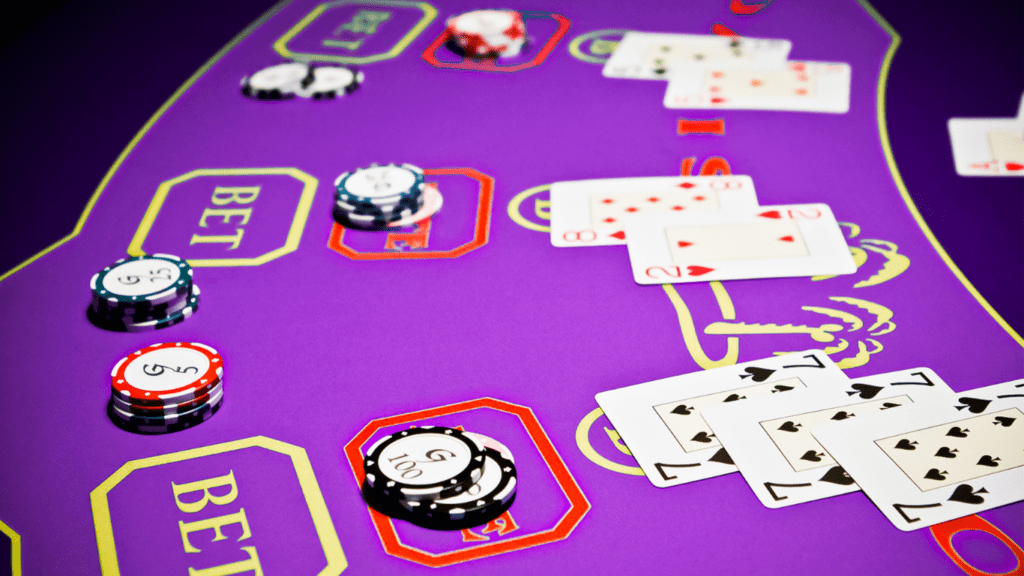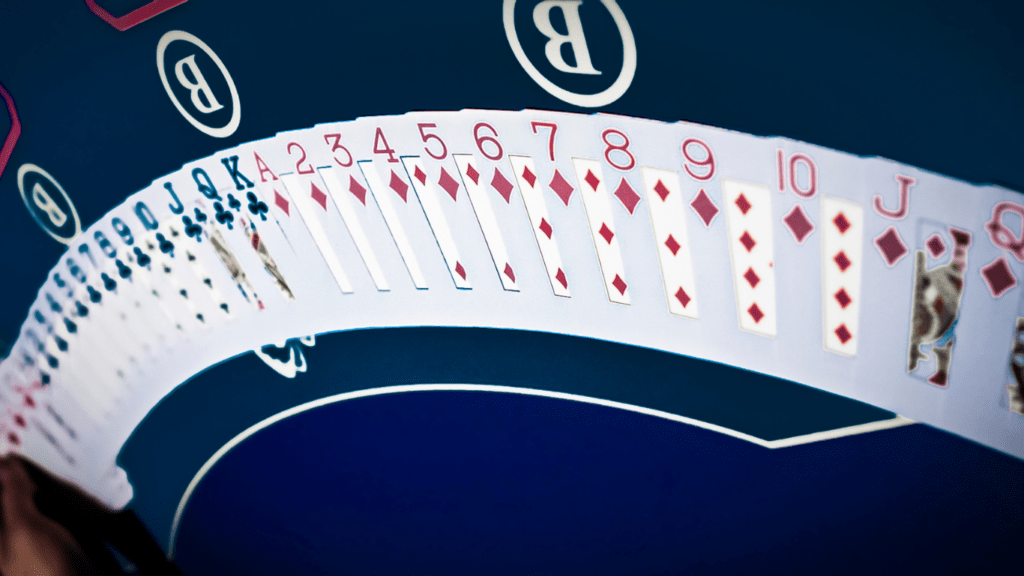Understanding Card Counting
Card counting in blackjack allows players to track the ratio of high to low cards left in the deck. It’s a skill that can give players a statistical edge over the house.
The Basics of Blackjack
Blackjack is a card game between players and a dealer. Each player seeks to beat the dealer by having a hand value as close as possible to 21 without exceeding it. Players start with two cards and can choose actions like:
- hit
- stand
- double down
- split
Aces count as either 1 or 11, while face cards count as 10. Understanding these basics aids in strategic gameplay.
The Concept of Card Counting
Card counting involves tracking high and low cards to predict the likelihood of favorable hands. High cards (10s, face cards, Aces) increase a player’s chances of winning, while low cards favor the dealer. By assigning point values to cards (e.g., +1 for low, 0 for neutral, -1 for high), one can calculate a running count as cards are dealt. This running count helps determine betting and playing strategies, enabling players to wager more when the count is in their favor.
The Mathematics Behind Card Counting
Card counting uses mathematical principles to give players an edge in blackjack. By understanding the probability of certain cards appearing, players can make informed decisions about their bets and moves.
High-Low Strategy
The High-Low Strategy is the most common card counting method in blackjack. In this system, players assign point values to cards to track their potential impact on the game. Cards 2 through 6 are assigned a value of +1 because their removal is advantageous to the player, while 10s, face cards, and aces are given a value of -1 since they favor the house when removed. Cards 7, 8, and 9 carry a value of 0, as they have a neutral effect. As I play, I maintain a running count by adding or subtracting these values. A higher count implies a deck rich in high-value cards, indicating a better probability for the player.
Other Popular Counting Systems

Beyond the High-Low Strategy, several other counting systems offer different levels of complexity and effectiveness. The KO (Knock-Out) system simplifies tracking by eliminating the need to convert a running count into a true count. True count conversion is unnecessary, making it beginner-friendly.
In contrast, the Omega II system assigns multiple point values to different cards, providing more precision at the cost of complexity. Finally, the Zen Count incorporates a wider range of point values to enhance accuracy, benefiting those comfortable with advanced counting methods. Each system caters to various skill levels and preferences, offering players a tailored approach to card counting.
Legal and Ethical Considerations
Understanding the legal and ethical aspects of card counting is crucial for anyone considering using the strategy. While card counting itself isn’t illegal, several factors make its practice complex.
Is Card Counting Legal?
Card counting remains legal because it uses mental skill rather than illegal devices. However, casinos, being private establishments, can prohibit suspected counters from playing. In some cases, if players win consistently, casinos might ask them to leave or ban them permanently. State laws on ejection policies vary, so staying informed about local regulations is essential before attempting card counting at a particular casino.
Casino Countermeasures
Casinos employ various methods to counteract card counting. These include frequently shuffling decks to reset the count, using continuous shuffling machines, and setting table limits to minimize losses. Additionally, some casinos train their staff to watch for large bet spikes as such fluctuations can indicate counting. Knowing these countermeasures helps players plan strategically and adapt their approach accordingly, minimizing the risk of detection.
Tips for Beginners
Gaining proficiency in card counting boosts success in blackjack and enriches your gaming experience. Here are key points to consider as you embark on this journey.
Practicing Card Counting
Practicing consistently sharpens card counting skills. I start by using a single deck of cards to master maintaining a running count. Regularly shuffle, deal card sequences, and revise my running count at the end of each round. As I become more confident, I introduce additional decks to simulate a casino blackjack table. Using online simulators and apps can also provide helpful practice opportunities. These tools reinforce accuracy and speed, essential for live blackjack games.
Managing Your Bankroll
Effective bankroll management is crucial for sustained play. I allocate a specific amount of money for sessions and commit to it, avoiding the urge to borrow more if my funds run out. This approach minimizes potential losses. By adjusting my bet sizes based on the running count, I maximize favorable conditions and limit risk during unfavorable scenarios. Staying disciplined in bankroll management ensures that I can enjoy my blackjack experience while employing card counting strategies without financial strain.
Common Mistakes to Avoid
- Overestimating Skills: Beginners often overestimate their card counting skills, which can lead to larger, riskier bets. Consistent practice and a solid understanding of counting systems are essential before increasing bet sizes.
- Ignoring Bankroll Management: Effective bankroll management is crucial. Some players forget to adjust bets according to their running count, risking their entire bankroll on poor hands. Sticking to a pre-set betting strategy helps in managing risks.
- Being Obvious in the Play: Acting conspicuously by frequently changing bet sizes or showing excitement can signal card counting to casino personnel. Practicing subtlety and maintaining consistent demeanor minimizes detection chances.
- Neglecting to Practice: Some overlook the practice aspect of card counting, assuming they’ll manage fine in a casino setting. Regular practice is necessary for maintaining accuracy and speed in keeping a running count.
- Counting Errors: Miscounting cards or losing track during a game disrupts the strategy’s effectiveness. Concentrating and checking accuracy during practice sessions reduces errors.
- Not Considering Casino Countermeasures: Players sometimes forget that casinos take proactive measures against card counters, like using continuous shuffling machines. Staying informed about such tactics aids in adapting strategies and avoiding pitfalls.



 Community Engagement Manager
Raymundo Stricklandics serves as the Community Engagement Manager for Dice Gamblers Deal, where he is dedicated to creating meaningful connections with the platform’s audience. His role focuses on fostering an active, engaged community of players by interacting with readers, answering their questions, and ensuring their experience with the site is both enjoyable and informative. Raymundo is deeply passionate about building relationships with fellow gambling enthusiasts, whether through social media, email communications, or direct interaction on the site’s forums. He works tirelessly to ensure that the platform not only provides valuable information but also offers a supportive space where players can share their experiences, tips, and success stories. Raymundo also plays a key role in customer support, addressing user inquiries and providing personalized advice to help players navigate the world of table games and betting strategies.
Community Engagement Manager
Raymundo Stricklandics serves as the Community Engagement Manager for Dice Gamblers Deal, where he is dedicated to creating meaningful connections with the platform’s audience. His role focuses on fostering an active, engaged community of players by interacting with readers, answering their questions, and ensuring their experience with the site is both enjoyable and informative. Raymundo is deeply passionate about building relationships with fellow gambling enthusiasts, whether through social media, email communications, or direct interaction on the site’s forums. He works tirelessly to ensure that the platform not only provides valuable information but also offers a supportive space where players can share their experiences, tips, and success stories. Raymundo also plays a key role in customer support, addressing user inquiries and providing personalized advice to help players navigate the world of table games and betting strategies.